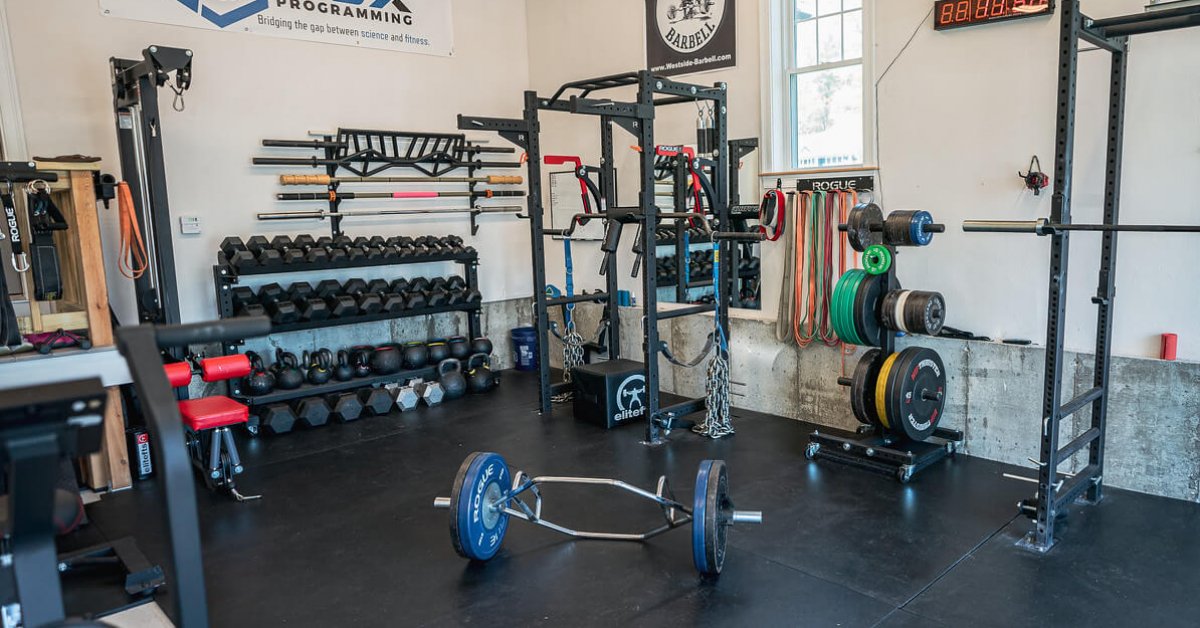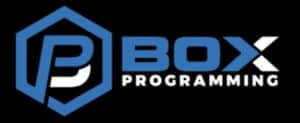Garage gyms have become quite popular over the last two years. In fact, out of nearly 700 videos on our YouTube channel, one of our most popular is the tour of my first garage gym.
Needless to say, the need to have the freedom to train when you want, how you want, paired with the convenience of being in your own home has given companies like Titan Fitness and Get Rx’D a massive customer base.
Moreover, individuals that used to train at a CrossFit box are perfect candidates for training on their own – most are familiar with big compound movements, how to perform them, and over the years have become self-sufficient in terms of training on their own.
This certainly has played a crucial role in empowering people to have the ability to feel confident enough to train on their own – many of those former CrossFitters are aware of how to push themselves and no longer need a screaming coach or the pressure of beating their peers in a WOD to do so anymore.
Additionally, many of these former CrossFitters may be simply burnt out and no longer have the motivation to “compete” daily – this is certainly something that resonates with myself and something we hear from new clients almost weekly.
Quick story
Back in 06′ I put together my first garage gym. I’ll be honest though – it wasn’t exactly “my” garage; it was actually my parents’ garage and I was lucky enough to take one bay hostage.
I had recently gotten into CrossFit coming from the strength and conditioning world and was training at a local gym. This gym actually had bumper plates and platforms which certainly isn’t the norm these days. However, the owner was a former professional football player-turned-offensive-line-coach and many of his athletes trained at this gym.
One day I was performing the workout “Linda” which any CrossFitter is probably aware of as well as just how devastating this workout is. It’s no coincidence that “Linda” is also known as the “3 Bars of Death.”
Nearing the end of the workout, I had dropped one of my deadlifts from the lockout – which to most in the CrossFit world is commonplace, but in a commercial gym with platforms, this could be seen as sacrilegious.
One of the members who was nearby, yelled at me to stop doing what I was doing. It was at that moment I knew I needed a new place to train if I was going to continue to train this way.
Fast forward two months I found out about a local strength & conditioning facility that was going out of business. I quickly grabbed a friend and went there to see what equipment I could buy.
All that was left was an Elitefts 3 x 3 rack and a few iron plates and for less than $700 I had the start of my first garage gym!
Almost 10 years later to the day when my wife and I purchased our first home, I still had that Elitefts rack on hand (you can see this in my first garage gym tour.)
This rack made it through my time away in the military and then to my first gym, and then to my first garage. It wasn’t until our second home garage gym that I realized, as much as I loved this rack, I could save a ton of space by simply downgrading to a half-rack.
With a garage gym, every square inch of space matters and over a short period of time our garage gym has evolved quite a bit.
Our current set-up
When I sold my gym I was able to keep a lot of the Westside Barbell Specialty Equipment I had, like the Athletic Training Platform, Standing Leg Curl, Hip Ab-developer, and a Reverse Hyper but eventually, I realized that as much as I loved this equipment, it wasn’t necessary for my training success.
But one piece we traded a lot of our original Westside Equipment for was the Inverse Leg Curl, which albeit definitely is not necessary for 9 out of 10 garage gyms, but for me and my wife, this piece is a staple in our training (the glute-ham raise is a staple in our individual streams of programming.)
The fact that my wife and I were no longer training anyone didn’t make sense to keep equipment on hand that took up the majority of our space not to mention it was hard to train with next to zero room to move around.
Instead, we opted for having more floor space and a second rack to make training with more than one person easier.
Here’s what our current set-up consists of and a video tour. Anything not linked is linked below in our lists.
- 2 Rogue R3 Racks
- Westside Barbell Inverse Leg Curl
- Rogue 45 Degree Back Raise
- Air Runner
- Rogue Echo Bike
- USA Strength & Performance Dual Handle Latpulldown (no link available – not sure if this company is still in business)
- Dumbbells up to 110#
- Kettlebells – 18s, 26s, 35s, 53s, 70s, 106s
- Fatbells – 18s, 26s, 35s, 53s, 70s
- Elitefts Bands
- Dual-Handle Lat Pulldown/Low Row
- Specialty Bars that include from Elitefts – SSB Yoke Bar, Football Bar, RhinoFlex Bar, T-Grip Bar, Bow Bar, Cambered Bar, Trap Bar, Various Fat Bars
- Rogue Plate Storage
- Rogue Bar Storage
- Rogue Bar Gun Rack
- Lots of specialty handles for the lat pulldown from EliteFts
- TRX Straps
- Thick Rope
- Westside Pulling Sled
- Rogue Butcher Sled with Wheelbarrow & low handle attachment
- T-Bar Row
- 200 lbs of 5/8 chain from Rogue
- Rogue AB3 Bench
Of course, there are lots of other little things like heavy medballs, slamballs, weight vests, that are reviewed in the tour.
Caveats to my recommendations
- Most of what I’m going to provide to you is a personal preference for the way I train
- I’ve provided three lists: your must-haves for starting out, the “once-you-have-the-essentials” list, and then “awesome-but-not-necessary” list
- You don’t need a huge budget but you do need at least a one-car garage or space comparable to outfit
- The recommendations I’m going to provide are based on what I know and have used – I wouldn’t feel comfortable recommending something I have not personally used, but luckily there are guys like Coop at www.garagegymreviews.com to provide you with literally a review on every piece of equipment imaginable
- You won’t see a barbell or bumper plates on this list as I’m definitely not the best person to recommend this stuff as I’ve had the same Eleiko bar that I purchased used almost 10 years ago as well as the same Rogue competition plates that my wife bought for me for Xmas in 15′, but I’d recommend checking out garagegymreviews.com for these
- Smaller things like foam rollers, lax balls, abmats are not included but are certainly things you to think about having on hand
- The best part about a garage gym is that you don’t need everything all at once – you can pick at it adding things slowly over time
Just starting must-haves
- Flooring – there are many options you can go with here, but the least inexpensive I’ve found that is not only tough (3/4 inch thick) and doesn’t look half-bad are horse-stall mats. These mats are 4 x 6 and depending on your space 6-8 mats will meet the needs of many (I have 12 mats + 1 additional I cut into squares for elevated deadlifts.) I’d recommend trying to buy these locally.
- Squat Rack – I get questions all the time about rack options, but my personal preference is a rack that allows me to pull rack deadlifts, perform multiple-grip pull-ups, perform a variety of exercises off of pins (Anderson squats, pin presses, ect) and allows me to set-up bands for accommodating resistance. I own two RM3 racks from Rogue and like all Rogue products that quality is second to none. On top of that, the amount of add-ons Rogue has for their racks is unlimited.
- Dumbbells – I’ve purchased the majority of my dumbbells from Walmart. Reason being, the shipping is usually free, the quality is decent, and the prices are insanely low. There’s nothing worse than purchasing something that costs more to ship than the actual product.
- Kettlebells – Another product I’ve purchased from Rogue. At first, I bought a 35, 53, and a 70# and over time I’ve added more to include two 106# as well as lighter bells.
- Bands – Good bands are a no brainer and incredibly versatile – grab yourself a set of micros, minis, monster minis, lights, and average bands from Elitefts and you’ll be good to with a long list of exercise such as these here.
- Pulling sled – I haven’t found many pieces of equipment as valuable as my pulling sled for about $100. I have an original Rogue Westside Sled – I know Westside sells these now for about $80. The list of benefits of the sled are endless that you can read about more here and even living in a colder climate like New England I still use my sled year-round.
- Landmine – Another incredibly versatile tool that can cover just about all of your training needs such as lunge variations, complexes, squats, presses, and more. My landmine attaches to my rack but you can buy the version that fits nicely in your bumper plates. Or at the very least you’ll need a corner to put your barbell in and you’ll be good to go.
- Bench – In my opinion, no garage gym is complete without a bench. I own both the Rogue AB3 and the Rogue Utility bench, but having an adjustable bench is definitely an added luxury – creating a slight decline or an incline can be accomplished by simply elevating the front or back of the bench on a few bumper plates. Moreover, the bench is about 16″ which is a nice a height to perform box squats with.
- Plyo Box – Another piece of equipment that may not seem like something that’s absolutely needed, but if you’re planning on effectively training your Type 2 fibers look no further than plyometrics. For a garage gym, you’re going to want a box that has multiple heights in one box so I opt for the Titan soft plyobox on Amazon.
- Plate Storage – There are a number of routes you could go with this one, but I’ll tell you that I started out with the “cheap” route with body-solid plate storage than in an effort to save space went with Rogues plate storage holder. Not only does this plate storage hold double what the body-solid version held, but it looks badass and is on wheels!
And then…
- Safety Squat bar – This one is higher up on the list than you may think mainly because this bar has been a game-changer in terms of pain-free squatting – the camber of the bar, the ability to use the handles, as well as a variety of uses such as JM Presses, Overhead Presses, and my all-time favorite Front Squat. And SSB Yoke bar from Elitefts is the industry standard.
- Chains – Definitely not a necessity, but nice to have to add variety to your routine, improve multiple levels of strength, as well as prevent injury vs. only using straight barbell weight. I go with the 5/8 chain from Rogue – I wouldn’t waste your money buying lighter ones than those. I also use the elitefts chain-loader with my chains.
- Fatbells – Another “nice to have” item – the fatbell presents a variation to the dumbbell where the weight is more symmetrical. These can turn normal exercises like presses into new variations.
- Pushing Sled – A conditioning tool “must” that I use regularly. I went the route of getting the Rogue Dogsled knowing that I could add a variety of attachments like the wheelbarrow – the wheelbarrow might be one of the best conditioning tools that many don’t know about. Westside Barbell made this one popular as they use the wheelbarrow regularly.
- Bar Storage – I have both the Rogue gun-rack as well as the Rogue Bar storage. If you begin to accumulate specialty bars like I have these will be important to maintain organization.
Bells & Whistles
This list is certainly things that can be put off, but over time these are things you may want to consider. These are listed in order of “most important” for my space.
Bringing it all together
Those that are willing to invest in a home gym are a special breed – there is no doubt that you take your health and training seriously.
In fact, these are EXACTLY the people we love to work with as they understand the value of great programming and a perfectly sequenced training session.
The growing garage gym community and people that have used our single sale programs was a large part of the motivation to create services like BPI and Rx Athlete to provide top-notch programming and coaching to those folks so they can get the best of both worlds being able to train at a home while still receiving guidance from experts.
Moreover, at BP we focused on working with the right clients so the relationship can mutually beneficial. Check out one of our clients Liz with her home-gym set-up. Liz actually started with me and my wife back in our gym owner days so she has a special place with us!


